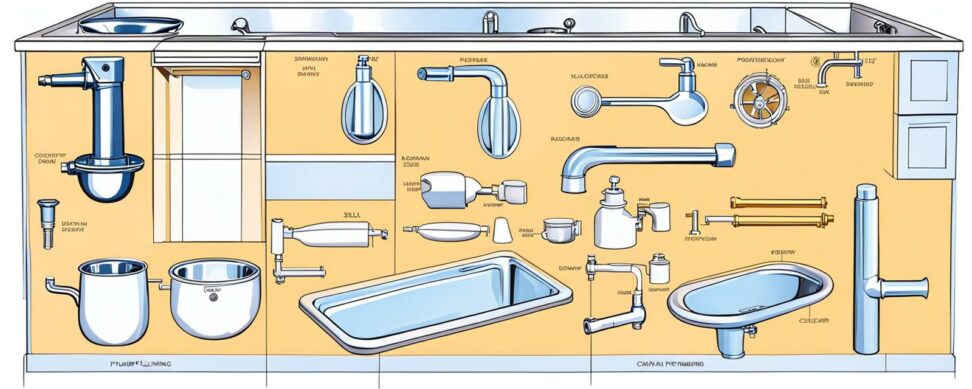Kitchen Sink Plumbing Parts Explained Clearly in One Simple Diagram
Having problems under your kitchen sink? Dripping faucet, slow drain, or mysterious leaks? Understanding the basic plumbing parts and connections helps diagnose issues and make repairs much easier.
We’ll look at a detailed diagram to understand how the parts fit and work together to drain water and deliver it to your faucet.

The Purpose of Kitchen Sink Plumbing
The plumbing under a kitchen sink serves two main functions:
- Efficiently drain water out of the sink
- Supply clean water to the faucet
The main components involved are the faucet, flexible supply lines, drain assembly and p-trap, and shutoff valves. Understanding how these core pieces connect is key to a properly functioning sink.
Faucet and Water Supply
The faucet mounts to the countertop or sink and controls water flow into the basin. Supply lines provide hot and cold water to the faucet from the shutoff valves located under the cabinet.
Shutoff valves are small knobs that connect to the main water supply lines. They allow you to turn on and off water right below the sink for easy repairs.
Drain Assembly
The drain assembly removes wastewater from the sink and connects to the main plumbing drainage pipes. It starts with the strainer basket in the drain opening to catch food scraps and debris.
A tailpiece attaches the strainer to the p-trap, which holds water to prevent sewer gases from rising up. The curved p-trap connects to the drain line that runs to the larger waste pipes.
Additional Components
Other common parts include:
- Sink pop-up release assembly - allows opening and closing the drain
- Garbage disposal - grinds food waste entering the drain
- Overflow drain - prevents sink from overflowing
Examining a Detailed Kitchen Sink Plumbing Diagram
Now let's look at a detailed kitchen sink plumbing diagram to get a visual understanding of how everything connects together.
The key takeaways are:
- Location of the hot and cold shutoff valves under the sink cabinet
- Flexible supply lines running from the valves up to the faucet
- P-trap positioned near the drain tailpiece with a slight downward slope
- Strainer basket sitting inside the sink drain opening
Make note of the direction of water flow from the supply lines down the drain. Tracing the path highlights the separate stages that allow a kitchen sink to function.
Identifying Specific Kitchen Sink Plumbing Parts
Now that we've seen how everything connects together, let's examine some of the specific components up close.
The Faucet
Faucets come in many varieties including single-handle, centerset, widespread, and pull-down. Materials are usually brass, stainless steel, or plastic with a chrome finish.
Some inner parts include the spout, control handles, cartridge, aerator, and flexible supply lines. The cartridge controls the faucet handle operation and water flow.
Drain Assembly
The strainer basket catches food debris but allows water to pass through. It connects to the p-trap via the tailpiece and a slip nut.
The p-trap has a curved tube designed to hold water and prevent sewer gas odors.
Supply Lines and Shutoff Valves
Supply lines are normally braided stainless steel for maximum durability. They connect from the shutoff valves up to the faucet.
Shutoff valves enable turning water on and off under the sink. Compression fittings allow for easy installation and removal.
Additional Components
A sink pop-up lift rod and clevis allows opening and closing the sink drain stopper. The garbage disposal usually connects to the drain tailpiece.
The overflow drain hole prevents water from spilling over the sink rim if the drain gets blocked.
Common Sink Leaks and Clogs
Understanding how a kitchen sink plumbing system works helps identify issues when problems pop up.
Some common causes of leaks and clogs include:
- Worn faucet washers or cracked gaskets
- Loose connections or cracks in the supply lines
- Drain clogs from built-up grease, hair, and food waste
- Misaligned p-trap arm preventing proper drainage
Professional Help for Plumbing Issues
While some repairs are doable yourself, certain jobs are best left to a professional plumber. We recommend hiring a plumber for:
- Installing a new sink or faucet
- Replacing supply valves or lines
- Snaking difficult drain clogs
Having a solid understanding of your kitchen sink's inner workings will help you diagnose problems and handle basic fixes. But don't hesitate to call a plumber for complex repairs or installations.
We've covered the main kitchen sink plumbing parts and how they connect together to allow proper drainage and water flow. Being able to identify the various components makes it much easier to spot and fix issues.
Use this guide as a handy reference when problems arise under your kitchen sink. And don't be afraid to tap a professional plumber for help when needed.